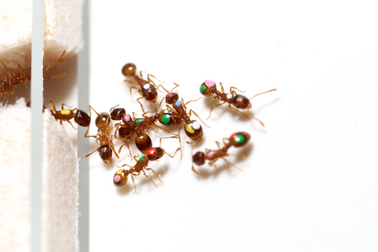Ants can change their priorities while househunting
All animals have to make decisions every day - often as a group to help their survival. Researchers from Arizona State University, hoping to understand how the collective decision-making process arises out of individually ignorant ants, have conducted an experiment which found that the creatures can change their decision-making strategies based on experience.
“The interesting thing is we can make decisions and ants can make decisions - but ants do it collectively,” said Takao Sasaki, a co-author on the research paper published in the journal Biology Letters. “So how different are we from ant colonies?”
Sasaki and his co-author Stephen Pratt gave a number of Temnothorax rugatulus ant colonies a series of choices between two nests with differing qualities. They first established a baseline by offering a choice between nests E and L, the former of which had a smaller entrance but a brighter interior.
“Because these ants have a strong preference for smaller entrances and darker interiors, this choice imposed a trade-off between the two attributes,” the researchers said.

In the treatment phase, colonies underwent a series of trials where they were induced to move from a standard nest to one of two sites: another standard nest, and one that was inferior in one attribute but identical in the other. For half the colonies, the inferior attribute was light level (the light treatment); for the other half, it was entrance size (the entrance treatment). The colonies usually moved to the superior standard nest.
Finally, the colonies were presented with the original binary choice between sites E and L to see whether the treatments had changed the ants’ attribute weightings. In both treatments, colonies shifted their preference towards the site favoured by the informative attribute; so after the entrance treatment, colonies that initially chose nest L were more likely to change than those that initially chose E, while the opposite pattern was seen for the light treatment.
“Of the 26 colonies assigned to the entrance treatment, only 10 chose nest E before the treatment, but this rose to 17 after the treatment,” the researchers said. “Conversely, for the 28 colonies in the light treatment, the number preferring L increased from 16 to 19.”

Pratt explained that because it is “very unlikely to find a home that has everything you want”, ants make various trade-offs for certain qualities, ordering them in a queue of most important aspects. But when faced with a decision between two different homes, the ants displayed a previously unseen level of intelligence by reprioritising their preferences based on the type of decision they faced. Like humans, they took the past into account when weighing up their options.
The difference, said Pratt, is that ants somehow manage to do this as a colony without any dissent. He said, “You have hundreds of these ants, and somehow they have to reach a consensus. How do they do it without anyone in charge to tell them what to do?”
Sasaki and Pratt hope to delve deeper into the realm of ant behaviour so that one day they can understand how individual ants influence the colony. Their greater goal is to apply what they discover to help society understand how humanity can make collective decisions with the same ease the ants display.
“This helps us learn how collective decision-making works and how it’s different from individual decision-making,” said Pratt. “And ants aren’t the only animals that make collective decisions - humans do, too.”
Light pollution promotes blue-green algae growth in lakes
Artificial light at night promotes the proliferation of cyanobacteria, also known as blue-green...
Solar-powered reactor uses CO2 to make sustainable fuel
Researchers have developed a reactor that pulls carbon dioxide directly from the air and converts...
Scientists simulate the effects of an asteroid collision
How would our planet physically react to a future asteroid strike? Researchers simulated an...




